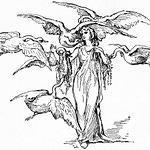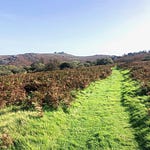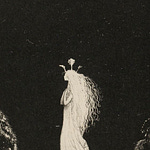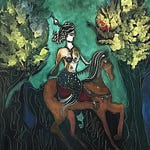
Practiced, sung and recorded through the winter solstice, new moon and now the edge of Christmas, as the Virgin Mary swells with child and comes to the eve of birth, I offer into this moment of celestial light and earthly dark a faithful rendition of the old Scottish borderland folk ballad Tam Lin (Child Ballad 39), accompanied and mixed by my brother Simon Linsteadt on guitar. You might enjoy listening to the song with a good pair of headphones before reading the explanatory notes below. Or read on and then listen after, as you wish. :) SOME NOTES ABOUT THE SONG I’ve loved the story of Janet and her Tam Lin since I was a girl and first encountered a version of the folk ballad in a fairytale anthology. What I was struck most vividly by as a girl was the tale's climax, when Janet, in order to win her beloved back from the retinue of the fairy queen, has to hold onto him while the queen of fairy changes him into a series of fierce, wild and dangerous beings, from bear to lion to adder to burning coal, and on, all through the long dark night. All she has to do, Tam Lin explains to her before the fated night, is not let go, and remember who he really is. But this is a terrifying and seeming impossible task. Hold an adder? Hold a red hot coal? I tried to imagine this as a girl of seven or eight, asking myself, could I do that? Could I hold on to a snake, to a lion, to a burning iron, to a dove, and not be afraid, and not lose my grip? I was amazed by Janet, inspired by her, and have loved her ever since. "First let pass the black black horse, And second pass the brown, But quickly run to the milk-white steed, And pull his rider down. . They'll turn me in your arms, Lady To an adder and a snake But hold me fast, and fear me not, for I am your bairn’s father." (Lyrics are my transliteration from multiple versions of the originals from Frances Child's 1860 English and Scottish Ballads, where he recorded 305 traditional ballads from England and Scotland, some as old as the 13th century. See all extant versions of Tam Lin here.) I met this story again as a grown woman when American folk singers Anaïs Mitchell and Jefferson Hamer put out an album of Child Ballads, one of which was Tam Lin. This led me down the labyrinthine road of all the various Tam Lin folk song versions, of which there are many, all strange and difficult to learn. It's a long song, a complicated story, challenging to keep the thread and energy of, but when done well it is entrancing. Mitchell and Hamer shortened it significantly, so that without prior knowledge of the story it's hard to know what's going on, though it's a gorgeous version. The folk singer who helped me get inside the singing of this song the best is Archie Fisher, the famous Scottish folk singer and ballad writer, whose gorgeous rendition uses the melody of another well-known Child Ballad called Willie of Winsbury, which has a bit more melodic movement than the usual Tam Lins (for me), and allows some of the emotion of the song to emerge more clearly. I've been meaning to properly learn this song for years, and suddenly, this December, it just happened. I sat down one day with all the existing versions of the ballad, stitched and pieced the story into one cohesive narrative (as all singers before me have done too in their own way with this song), modified the language only so as to make it understandable in modern English, and then began to sing. And there it was. Tam Lin, come to life for me at last in my voice. Thank goodness, my absolutely brilliant brother Simon (please do yourself the favor of exploring his many albums, he's one of the great creative inspirations in my life) arrived a week later and in about five minutes had this most gorgeous guitar part going by the fire in my house. From there, the whole song began to live. It's an old, old story, you can feel it in the cadence of its words and the cadence of its images, its narrative moves. It enchants me deeply. It puts me in a kind of trance. It heals something in me too, every time I let the words and notes touch me. May it do so for you too, in this holy dark birthing heart of the year.
SOME NOTES ABOUT THE STORY I've chosen not to share my version of the lyrics here, because I want you to have a purely oral experience of the story. It's a deep and strange one, and deserves a bewildering first listen. I will however provide a synopsis, so you have something to hold on to, because the language is old and twisting, and the song leaps between scenes, expecting its listeners to know the story well enough not to need too much explaining. So, there's a place in the woods somewhere in the far north of England on the border with Scotland called Carterhaugh. There are stories of a man who guards over these woods, forbidding all to enter unless they are willing to give him a gift— "either gold rings or green mantles, or else their maidenhead." The speaker is warning the young maidens not to go to this bit of wood. Immediately, the story is in high gear, and also in uncomfortable terrain, given how some of the versions articulate Tam Lin's nature here — that he does not "ask the leave" of these maidens before taking their maidenheads. This has never sat well with me— for the obvious reasons, but also because of a couple pieces of narrative logic, and a few versions in which it's implied that Janet actually goes willingly and gladly with him down among the roses red. In terms of narrative logic, right after this alarming opening declaration, a young maiden named Janet pops up in the lyrics, saying— well I want to go there. See if you can stop me. And then she "kilts" her green mantle up above her knee, and braids her yellow hair prettily over her brow, and off she goes at great speed to Carterhaugh, looking her best. I love this. I love her cheek, her boldness, her open desire— a strapping elf-knight in the woods, you say? I'll go see for myself.... Because of this detail, as well as her clearly devoted love for Tam Lin later in the story, I'm fairly convinced that the implied rape versions are attempts at covering up the female sexual independence (and active desire) that's actually at the song's heart. In the 16th century Scottish borderlands, it does not look well for a young woman to want to be ravished by a man in the woods, to actually go and seek him out, to choose the encounter herself. But this is exactly, I believe, what the first part of the story is about. And so the song goes on. She picks roses boldly where she isn't supposed to, Tam Lin appears and asks what she's doing, why she's pulling roses here in his forest. And she retorts (you can feel the flirtation simmering), this isn't your wood, it's mine, my father gave it to me, I'll come and go as I please, I don't need your permission. We can imagine they circle each other a bit more, they banter, they chat, they wander the wood, the light is thick, and then he takes her "milk-white hand" and lays her gently down and, as generations of singers have hummed: "what they did I cannot say, but she ne'er returned a maid." Time passes, we see Janet looking very pale among the ladies of her father's house. Her father himself notices too and speaks up, asking her if she is with child. Yes, she says, she is, but not to any man on earth. Her child's father is an elf, she says, and she is not sure it is possible to bear the child. Then she rushes back off to Carterhaugh in distress (but also makes sure to beautify herself first, "by the bright light of the moon") to seek an abortive herb, because she fears the child she will bear will be a "wild shade," not a child of this earth. Tam Lin finds her there, and she demands to know the whole truth of who he is and how he got to be in this wood, and if he's really fully a fairy or has ever been baptised. Yes, I was once of the world just like you, he tells her, but he was stolen by the queen of fairies and has been kept there among her retinue because (it is implied at the song's end) she is in love with him. But, he tells Janet, every seven years the fairies make a sacrifice to hell, and this year he's worried it will be himself. This very night, he says — all hallow's eve— they will ride.
Now here I took a small liberty with the lyrics, and replaced "all hallow's eve" with "winter's eve," because there are Northern European traditions of the Wild Hunt riding out through the 12 nights of Christmas, as well as on the eve of Celtic Samhain referred to here. And because in the old Celtic tradition it is Samhain that is the beginning of winter and solstice its middle, my "winter's eve," can be either, held within the frame of the dark descent of the year. I wanted this version of the song to feel as though it were happening this very night, when so much magic is afoot, so much miraculous birth and transformation and great beams of light returning. Tam Lin explains to Janet that in order to save him from the fairy queen and turn him back into a human man, she has to go to Miles Cross this very night, and wait at the crossroads for the queen and her fairy court to pass. He tells her which horse to wait for— the milk white steed, which is his own— and then to pull him down and hold him fast as the fairies change him into all manner of things, as mentioned above. At the end, he tells her, he'll turn into a naked knight in her arms, and she'll have to wrap him in her green mantle, and then he'll be saved, and she'll have won her true love and the father of her child. I'll leave the end itself for the song's telling, so that there is a little mystery left. But I want to add one last thing about the most powerful image at the song's heart. This long, long dark night when Janet holds Tam Lin tight and fears him not, "for he is her bairn's father," even as he changes into fearsome and violent beasts, as well as fiery coals, and in some versions iron tongs or a flaming sword. Within this is a powerful reflection about beholding the people we love even at their most difficult, even when every beast emerges, and possibly all seven deadly sins, and yet cleaving fast to the knowledge of their true selves ("hold me tight and fear me not, for I am your own true love") and so, by this truth, finding the capacity to stay, and keep staying, and behold, and keep beholding, until the naked self emerges. Within this is also a reflection about how we expand beyond the human in our natures. How we each contain unfathomed wildness— bears and lions and fires and swans. It's glorious, and overwhelming, and definitely not easy. Consent is of course implied— he has asked her to help him, to hold him, and she wants to do so, is happy to do so, feels safe to do so, etc. Questions and qualifications like this naturally arise when the logical, well-therapied brain takes over — clinging is definitely not what we are going for, nor is tolerating abusive behavior, obviously. So let's remember that this story moves outside the language of the brain, and inside the language of heart and of soul. And in that place it offers perhaps as much guidance and wisdom about our state of inner union, inner marriage, as it does about the outer. This is about the one in us who is Janet, who can hold the one in us who is Tam Lin at the crossroads at the dead dark pit of night, and let the fairies do their worst, for she is not going to forget who he really is, who she really is, who they really are as one whole, for she also loves the lion, the snake, the coal. My god do I know this feeling— the one who is a thrashing lion within, the one who is an adder, striking, the one who is a red-hot coal, the one who is dove, slipping away, all of them seeming to turn on me, all of them really in fact seeking my presence, my beholding, my unwavering trust and love. But hard days, or hard seasons, or hard years, can look a bit too much like this scene at the crossroads, gone awry. A rather more frenzied version of it where Janet gets scared, gets bitten, gets burned, and so turns away, and has to come back another time to try again. I think we've all failed at this crossroads many times. I think we've all also triumphed many times, and will continue to do both. But perhaps with a bit of Janet's pluck to inspire us, and the full dose of Tam Lin's love for her and hers for him, both worldly and otherworldly, we can feel courage to try again, to love ourselves and each other with more presence and more acceptance, and to go with green mantles kilted where we are most called, even if we are afraid.
NOTE ON THE ARTWORK
The paintings in the second half of the post are by the contemporary Hungarian painter Döbröntei Zoltán, whose work seemed to speak to the interior experience I have of the Tam Lin story. I know it’s not very purist of me to illustrate a Scottish Borders folktale with Hungarian paintings, but there you have it. They are wild and luminous, spiritual and haunting, and they wanted to be here, so I let them. :)













